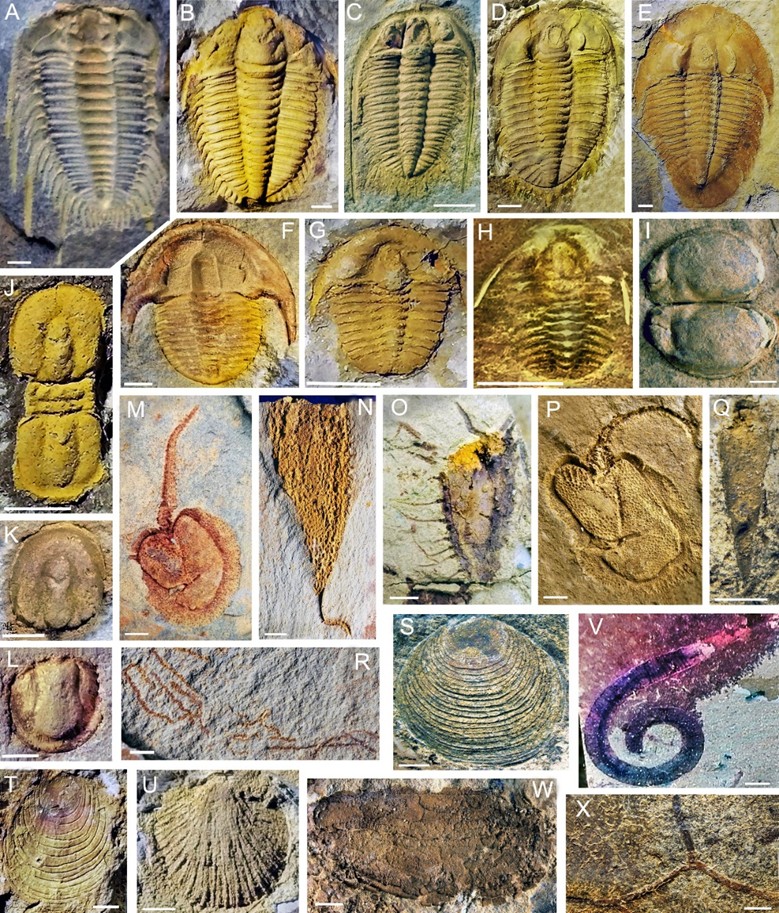Longha Fm
Type Locality and Naming
The type section of the Longha Formation is the Tianpeng-Bocaitian section (105°25’E, 23°19’N), It is lower-middle portion of the same type section shared by the underlying Tianpeng Fm and overlying Tangjiaba Fm and Bocaitian Fm, lying 9.5 km northwest of the Tianpeng Town, or about 40 km southwest of the seat of Funing County. The section spans the border between Funing and Malipo counties with the Tianpeng Fm belonging to Funing County on the east and Bocaitian Fm belonging to Malipo County on the west. It was measured by the Guangxi Bureau of Geology and Guangxi Reginald Survey Team in 1965. The Longha Formation was published by Liu Yuanzheng et al. (1965) from Geological Bureau of Guangxi Zhuang Autonomous Region. The name is derived from Longha Village in Tianpeng Township, Funing County, southeastern Yunnan Province, and was originally appeared in a 1964 manuscript by the No. 4 Brigade of Yunnan Regional Geological Survey Team.
Synonym:
Lithology and Thickness
The Longha Formation is mainly a carbonate sequence. In the type section, the formation is divided into three informal members, from bottom up: (1) Lower member consists of light grey, medium-bedded dolomitic limestone with a layer of yellowish brown siltstone and mudstone, 20 m thick, at its base (220.0 m thick); (2) Middle member consists of light yellow and light grey, thick-bedded argillaceous limestone and dolomitic limestone with interbeds of siltstone and mudstone at its lower part (112.0 m); and (3) Upper member consists of light grey to dark grey, thick-bedded dolomitic limestone, alternated with argillaceous limestone (400 m). In the type section, the Longha Formation is 732 m thick.
Relationships and Distribution
Lower contact
The Longha Formation is in conformable contact with the underlying Tianpeng Fm. The lower boundary of the formation is defined by lithological change from the mudstone of the Tianpeng Fm to thick-bedded dolomitic limestone at the base of the Longha Fm.
Upper contact
The Longha Formation is in conformable contact with the overlying Tangjiaba Fm. The upper boundary is marked by lithological change from thick-bedded dolomitic limestone to micaceous silty mudstone at the base of Tangjiaba Fm.
Regional extent
Longha Formation is exposed in the southeastern part of the Yangtze Area of South China Region, very close to the Jiangnan Slope Area, distributed in the counties in southeastern corner Yunnan Province, including Finning, Guangnan, Maguan, Wenshan and Xichou counties belonging to the Wenshan Zhaun-Miao Autonomous Prefecture and Menzi and Pingbian counties belonging to the Honghe Hani-Yi Autonomous Prefecture. It also exposed in most western Guangxi Zhuang Autonomous Province, including Longlin and Jingxi counties. Southeastward, the formation increases interbeds of clastic rocks, and the thickness as well. The thickness varies between 588 m in Menzi area in the west and 2395.2 m in Fulu area of Tianpeng Township in the east.
GeoJSON
Fossils
In the type section, the lower member of the Longha Formation yields trilobite Solenoparops meridionlaris and the middle member yields trilobites Damesella brevicaudata and Taitzuia sp. In a section at Fulu in Tianpeng Township, the lower part of the middle member yields a biota with multiple fossil groups (Peng at al. 2020b) , which is dominated by diverse trilobites, including Agnostus, Ammagnostus, Bergeronites, Blackwelderia, Clavagnostus, Damesops, Hadragnostus, Karlanus, Kormagnostus, Liostracina, Monkaspis, Palaeadotes, Paracoosia, Teinistion, and Torifera, and non-trilobite fossil groups including brachiopods, bradoriid arthropods, echinoderms, priapulids (worms), hyoliths, large bivalved arthropods, macroscopic algae, and trace fossils.
[Figure: Some taxa of the Fulu Biota from the lower part of the middle member of the Longha Formation at Fulu Village, Funing County, southeastern Yunnan Province. A−H, polymerid trilobites: A, Bergeronites sp., exoskeleton; B, Damespos sp., exoskeleton; C, Tienistion sp., exoskeleton; D, damesellid gen and sp. , exoskeleton; E, Paracoocia sp., exoskeleton; F, Liostracina sp., exoskeleton; G, Torifera sp., exoskeleton, H, shumadiid gen. et sp., exoskeleton; I, bradoriid Anabarochilina sp., J−L, agnosoid trilobites: J, Agnostus sp., exoskeleton; K, L., Ammagnostus sp., cephalon and pugidium; M−P, echinoderms: M, P, cothurnocystid gen. and sp.; N, eocrinoid gen. and sp.; O, spiny eocrinoid gen. and sp.; Q, hyolithid gen. and sp.; R, macroscopic algae Doushantuophyton sp.; S−U, brachiopods: S, T, obolid gen. and sp.; U, othriid? gen. and sp.; V, priapulid (worms), plaeoscolecid gen. and sp.; W, large bivalved arthropod Canadaspis sp.; X, Trace fossil. All scare bars = 2 mm.]
Age
Depositional setting
Additional Information
